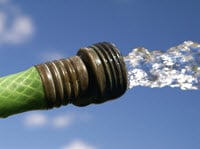How Can I Find Out What My Well Pump Flow Rate Is?
Well Pump Flow Rate Questions?
One question we often get is: “How can I find out what my well pump flow rate is??”
Iron filters, acid neutralizers, and other well water treatment systems are available in different sizes. When selecting a water treatment system, you must know the well pump flow rate in gallons per minute.
Determining your well pump's flow rate in gallons per minute is important before choosing an iron filter or other treatment system.
This is very important, but it is easy to figure out. You can easily get a good approximate figure of the flow rate yourself.
Turning on a spigot near the well won't work, and timing the water running into a bucket won't work. This is not accurate. After all, a hose bib (or spigot) usually restricts the flow rate because the hose bib is usually a smaller diameter than the pipe.
However, you can check the flow rate more accurately yourself. All you need is a 5-gallon bucket and a watch or timer on your phone. Time how long it takes for the well to fill up your pressure tank. See the simple instructions below.
What IS Flow Rate Anyway?
Flow rate is simply how many gallons can be pumped from the well in one minute. It is generally determined by the size of your well pump and also affected by its capacity.
For example, if your well pump can fill a 5-gallon bucket in 60 seconds directly from the well, you can consider yourself to have 5 Gallons Per Minute (GPM).
Most homeowners have a standard single-speed submersible pump with a pressure tank on their private wells. This test is for this standard type of pump and pressure tank. If you have a ‘constant pressure’ or variable-speed pump, this test, described below, won’t work.
Constant pressure systems often have very small pressure tanks or expansion tanks about the size of a beach ball. Standard pressure tank systems have larger (typically blue-colored) pressure tanks.
With standard submersible pump systems, the pump typically turns on when the pressure drops to 30 to 40 PSI and turns off when the water pressure in the pipes and pressure tank builds up to 50 to 60 PSI.
As the high pressure (Cut-Off) point is reached, water flows into the pressure tank and builds up pressure. When the high-pressure level is reached, the pressure switch turns off the well pump.
 Why Measuring Flow Rate is So Important
Why Measuring Flow Rate is So Important
Most iron filters and other well water treatment systems require approximately twice the backwash flow rate as the service flow rate.
A good flow rate is required to properly backwash the filter systems and provide the home with good water pressure.
Matching your Iron Filter and Well Pump
Say you want to install an iron filter that requires 8 gallons per minute to backwash and flush out accumulated iron in the filter properly.
However, your well pump can only pump 7 GPM. If that is the case, you would need a smaller iron filter that can backwash at 7 GPM. You can also install two smaller iron filters in parallel.
Another option would be to increase the size or output of the well pump by replacing it. Often, the well is not designed or doesn't have the capacity to pump higher output of water.
Yet another option is to install a small storage tank. The water flows from the well into the tank first, and then a booster pump with an adequate flow rate can boost the pressure after the tank.
Simple Steps to Take
To estimate your well pump's flow rate, you'll need a bucket and a timer. This method works for standard well systems with a pressure tank and pressure switch, not for constant-pressure systems.
- Run water until the well pump turns on (you’ll hear a click or the pump noise).
- Turn off the faucet and let the pump build pressure until it shuts off.
- Open a nearby hose bib and collect water in a 5-gallon bucket. Dump and repeat if needed.
- When the pump turns back on, note the total gallons collected, then close the hose bib.
- Time how long (in seconds) it takes the pump to shut off again as it builds pressure.
- Use the formula:
(Gallons ÷ Seconds) × 60 = Gallons per Minute (GPM)
For example: (20 ÷ 120) × 60 = 10 GPM
Why This Matters
Knowing your flow rate helps assess system performance and is important if you're installing new filters or pumps. If you have a constant-pressure system, contact your well contractor or send us your specs—we’ll help you determine your flow rate.

See our ON-LINE CALCULATOR to make it faster and easier.

















